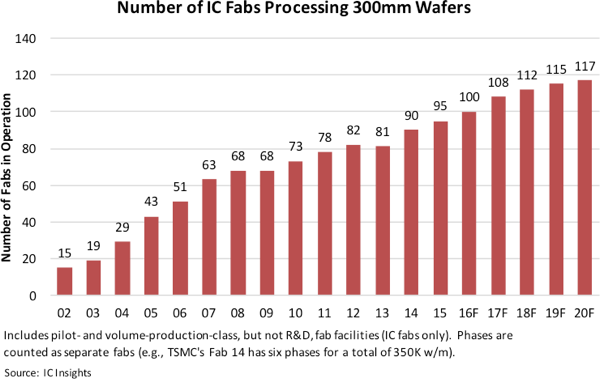High volume 450mm IC wafer fabs not expected until after 2020.
IC Insights recently released its new Global Wafer Capacity 2016-2020 report that provides in-depth detail, analyses, and forecasts for IC industry capacity by wafer size, by process geometry, by region, and by product type through 2020. In 2008, 300mm wafers took over as the industry’s primary wafer size in terms of total surface area used. Furthermore, the number of 300mm wafer fabrication facilities in operation continues to grow and is expected to reach 100 this year (Figure 1).
Some highlights regarding 300mm wafer fabs are shown below.
• A couple fabs that were scheduled to open in 2013 were delayed until 2014. That, in conjunction with the closure of two large 300mm fabs by ProMOS in 2013, caused the number of active volume-production 300mm fabs to decline for the first time in 2013.
• At the end of 2015, there were 95 production-class IC fabs utilizing 300mm wafers (there are numerous R&D IC fabs and a few high-volume fabs that make “non-IC” products such as CMOS image sensors using 300mm wafers, but these are not included in the count).
• Currently, there are eight 300mm wafer fabs scheduled to open in 2017, which would be the highest single-year increase since 2014 when nine 300mm fabs were added.
• By the end of 2020 there are expected to be 22 more 300mm fabs in operation, bringing the total number of 300mm fabs used for IC fabrication to 117. If 450mm wafers enter production, the peak number of 300mm fabs may be somewhere around 125. For comparison, the highest number of volume-production 200mm wafer fabs in operation was 210 (in December of 2015 there were 148).
Today’s 300mm wafer fabs can be huge, but they are being equipped in a modular format, with each “module” generally having the capacity to process somewhere around 25K-45K wafers per month. Each module is closely connected to nearby fab modules. TSMC has perfected this modular approach, with its Fab 12, 14, and 15 sites being expanded in phases.
Figure 1
Development of 450mm wafer technology continues to progress toward production, albeit at a tempered pace. Since lithography is one of the biggest challenges in the 450mm wafer transition, ASM Lithography’s announcement in March 2014 that it would temporarily hold off on the development of equipment for 450mm wafers made some in the industry believe it was a signal that the transition would never happen. ASML reported also that the decision to postpone its 450mm development program was made at the request of its customers.
IC Insights does not believe that ASML’s announcement, along with a couple other signs of a pause in 450mm development, means the 450mm wafer transition won’t happen, but they do indicate that the pilot production status for 450mm won’t be reached until probably 2019. Volume production might start two to three years after that.
Report Details: Global Wafer Capacity 2016-2020
IC Insights’ Global Wafer Capacity 2016-2020—Detailed Analysis and Forecast of the IC Industry’s Wafer Fab Capacity report assesses the IC industry’s capacity by wafer size, minimum process geometry, technology type, geographic region, and by device type through 2020. The report includes detailed profiles of the companies with the greatest fab capacity and gives comprehensive specifications on existing wafer fab facilities. Global Wafer Capacity 2016-2020 is priced at $4,290 for an individual user license. A multi-user worldwide corporate license is available for $6,990.



















